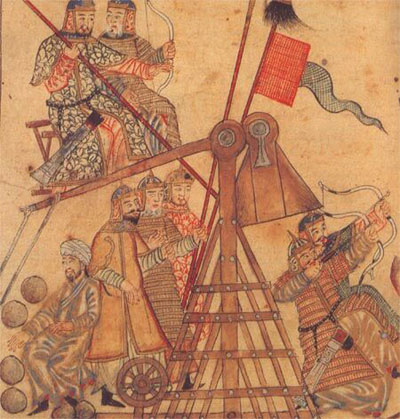Exhibit I:
Did the Mongols encourage trade and cultural exchange in the civilizations they conquered?
 Source: Caravane Marco Polo, Iconnu, Atlas cataln, Wikimedia
Source: Caravane Marco Polo, Iconnu, Atlas cataln, Wikimedia
The movement of peoples resulted in exchanges of goods, ideas and styles and in frequent and widespread contact between peoples of widely different cultural, ethnic, religious, and language backgrounds.
- Thousands of people traveled from western and central parts of Eurasia to serve the Mongol regime in China.
- Marco Polo, the Venetian merchant who traveled to China with his father and uncle in 1271 and remained there for seventeen years, was just one of these foreigners seeking opportunity in Mongol administration.
- Genoese merchants, who traded extensively in the Muslim lands and Inner Eurasia in the Mongol era, sold Chinese silk and "Tatar cloth" at the fairs of Northern France.
- Chinese artisans designed ceramics especially to appeal to Muslim tastes.
- The Chinese exported copper and iron goods, porcelain, silks, linens, books, sugar, and rice to Japan and Southeast Asia in return for spices and exotic items like rhino horns.
- At the time of his death in Italy, Marco Polo had among his possessions a Mongol slave, Tartar bedding, brocades from China, and a Buddhist rosary.
- Kublai Khan had Persian copies of the works of Euclid and Ptolemy translated into Chinese.
- Egyptian experts were called in to improve Chinese sugar-refining techniques.
- Muslim medical and astronomical sciences became known in China. Chinese medical works were translated into Persian.
- Buddhist monks built Chinese style pagodas in Persia.
- Persian miniatures show Chinese-style mountains and dragons.
- A Mongol version of the traditional stories about Alexander the Great was produced.
- Diplomatic contact with Western Europe intensified.
 Source: Caravane Marco Polo, Iconnu, Atlas cataln, Wikimedia
Source: Caravane Marco Polo, Iconnu, Atlas cataln, Wikimedia
 Source: Caravane Marco Polo, Iconnu, Atlas cataln, Wikimedia
Source: Caravane Marco Polo, Iconnu, Atlas cataln, Wikimedia